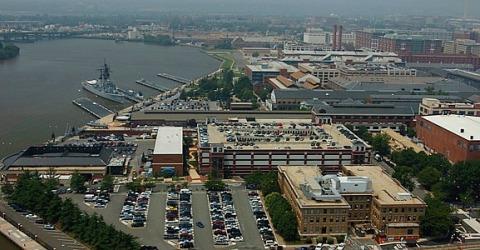Newtown, Connecticut. Aurora, Colorado. Oak Creek, Wisconsin. Seattle, Washington. Oakland, California. Carson City, Nevada. Tucson, Arizona. Binghamton, New York. Fort Hood, Texas.
Add another name to that list. The District of Columbia.
This morning, Washington, D.C., became another name on a list of mass, multiple shootings which have sent cities, even one as security-conscious as the capital of the United States, into a nerve-wracked, chaotic emotional and media-state after the suspected shooter—identified as Aaron Alexis, 34, of Fort Worth, Texas—entered the Naval Sea Systems Command Headquarters building at the historic Navy Yard near Nationals Park and allegedly killed at least 12 persons. Alexis is also known to have been killed.
The scene shown on television—press conferences, people walking outside of the area, television and print reporters descending on the area, tense officials announcing the latest information on the number of dead—looked both like scenes from another country and another place and familiar.
The other shootings over the past 15 years took place in restaurants, community centers, a movie theater, an elementary school, a coffee shop, a church, a military installations. All played out to the sound of rapidly fired gunshots, sounds that have not yet reached the level of being commonplace.
Mayor Vincent Gray, Metropolitan Police Chief Cathy Lanier and other local law enforcement officials, including those of the U.S. Park Police and the FBI, and hospital officials gave out scattered bits of news to what remains a shocking event. No one could clearly remember anything quite like this. There have been attempted bombings, or shootings here, and there was a disastrous 1982 plane crash over the waters of the Potomac and the takeover of the Islamic Center and going back to the 1940s, the shootings in Congress by Puerto Rican militants.
President Barack Obama said: “We’re confronting yet another mass shooting and today it happened on a military installation in our nation’s capital. … These are men and women who were going to work doing their jobs and protecting all of us. They’re patriots. They know the the dangers of serving abroad, but today they faced the unimaginable violence that they wouldn’t have expected here at home.”
“I am deeply saddened by today’s senseless act of violence, which is the deadliest single incident in the District in more than three decades,” Gray said. “I want to express my deepest sympathies to the families of those whose lives were lost, and my thoughts and prayers are with those who suffered injuries – and particularly our first responders, who reacted to this incident with unflinching and unstinting bravery.”
Secretary of the Navy Ray Mabus called the shootings “a horrific attack” and “stunning blow” against the U.S. Navy.
In a heartfelt response to the crime and her caring for the wounded at the Washington Navy Yard, MedStar Washington Hospital Center Chief Medical Officer Janis Orlowski said, “There’s something evil in our society that we as Americans have to work to try to eradicate. … I would like you to put my trauma center out of business. I really would. I would like to not be an expert on gunshots. … Let’s get rid of this. This is not America.”
But something like this is a scene where confusion reigns amid the fog of blogs—wrong information merges with facts, a kind of information chaos is created. No one yet at this writing has mentioned motive in the case of Alexis, who was identified as a civilian navy contract who may have gained entry to what is considered one of the most secure buildings of the District of Columbia with an ID not his own.
Police have secured the area. The wounded are at the hospital. Workers at the Navy Yard have left the shut-down buildings. Flags are already at half-staff, the school lockdowns ended, traffic at M Street, SE, detoured and events postponed, including tonight’s Nationals-Braves game and music concert at the White House.
Those dozen killed we will soon learn of — and their families’ grief we may hardly know. So, how will we feel — and deal with such tragedies — tomorrow?


